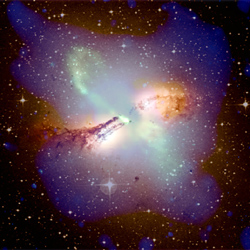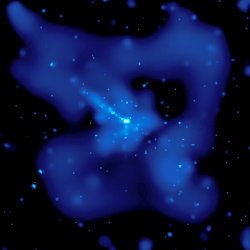CXC Release: 02-08
CXC Release: 02-08
RELEASE: 97-48
Long ago, a giant eruption occurred in a nearby galaxy and plunged it into turmoil. Now NASA's Chandra X-ray Observatory has revealed the remains of that explosion in the form of two enormous arcs of hot gas. This discovery can help astronomers better understand the cause and effect of violent outbursts from the vicinity of supermassive black holes in the centers of many so-called "active" galaxies.
Scientists from the Harvard-Smithsonian Center for Astrophysics (CfA) report that two arc-like structures of multimillion-degree gas in the galaxy Centaurus A appear to be part of a ring 25,000 light years in diameter. The size and location of the ring suggest that it could have been produced in a titanic explosion that occurred about ten million years ago.
A composite image of the galaxy made with radio (red and green), optical (yellow-orange), and X-ray data (blue) presents a stunning tableau of a tumultuous galaxy. A broad band of dust and cold gas is bisected at an angle by opposing jets of high-energy particles blasting away from the supermassive black hole in the nucleus. Lying in a plane perpendicular to the jets are the two large arcs of X-ray emitting hot gas.
"Putting all the images together was the key to understanding what Chandra showed," said Margarita Karovska, lead author on a paper in the September 20, 2002, issue of The Astrophysical Journal. "Suddenly it all clicked in, as with a giant puzzle, and the images fit together to make a complete picture of the galaxy geometry that was not at all apparent before."
The team proposes that the orientation of the arcs of hot gas perpendicular to the jet and the symmetry of the projected ring with respect to the center of the galaxy could be evidence that the ring is the result of a giant eruption in the nucleus of the galaxy 10 million years ago. This explosion may have produced a galaxy-sized shock wave that has been moving outward at speeds of a million miles per hour. The age of 10 million years for the outburst is consistent with other optical and infrared observations that indicate that the rate of star formation in the galaxy increased dramatically at about that time.
Other authors have suggested that the merger of a small spiral galaxy with Centaurus A about a hundred million years ago triggered the high-energy jets and the ongoing violent activity in the nucleus of the galaxy. The tremendous energy released when a galaxy is "turned on" by a collision can have a profound influence on the subsequent evolution of the galaxy and its neighbors. The mass of the central black hole can increase, the gas reservoir for the next generation of stars can be expelled, and the space between the galaxies can be enriched with heavier elements.
"Active galaxies could have played a significant role in the evolution of galaxies in the early universe when collisions between galaxies were much more frequent," said Giuseppina Fabbiano, a coauthor on the paper. "Centaurus A, at a distance of only 11 million light years, gives us a rare opportunity to study such an active galaxy in action."
Chandra observed Centaurus A with its High Resolution Camera instrument on September 10, 1999, for approximately 4.7 hours. Other members of CfA research team include Martin Elvis, Ralph Kraft, Stephen Murray, and Fabrizio Nicastro
The HRC was built by the Smithsonian Astrophysical Observatory in Cambridge, Mass. NASA's Marshall Space Flight Center, Huntsville, AL, manages the Chandra program for the Office of Space Science, Washington, DC. TRW, Inc., Redondo Beach, California, is the prime contractor for the spacecraft. The Smithsonian's Chandra X-ray Center controls science and flight operations from Cambridge, MA. MEDIA CONTACTS
Steve Roy
Marshall Space Flight Center, Huntsville, AL
Phone: 256-544-6535
Megan Watzke
Chandra X-ray Observatory Center, CfA, Cambridge, MA
Phone: 617-496-7998
cxcpress@cfa.harvard.edu




